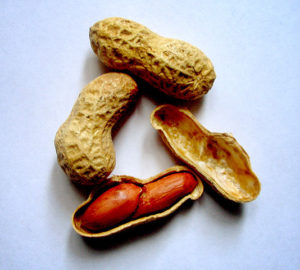by Tessa McGartland; St. Louis University SLI Program (St Louis, MO)
Heartless Nature 2 by SciJourner on Scribd

This work is licensed under a Creative Commons Attribution-NonCommercial-NoDerivs 3.0 Unported License

By Alyssa Vandiver and Ashley Phan; Farnsley Middle School (Louisville, KY)
Teacher: Marsha Buerger
Most of us have heard that dark chocolate can benefit your health because of the amount of antioxidants in it. However, many younger people prefer the sweet milk chocolate than the bitter dark chocolate. In a quick survey of middle school students at Farnsley Middle School, 51 out of 58 (88%), said that they preferred milk chocolate, while only 7 out of 58 (12%) preferred dark chocolate.
An article by Kati Mora, a registered dietitian, on http://www.fitnessmagazine.com, a website that provides articles about health, exercise, and nutrition, stated that milk chocolate is less healthy than dark because milk chocolate does not contain as many cocoa beans as dark chocolate. Even though milk chocolate does have cocoa solids, it is mixed with more milk solids, sugar, and cream than dark. Cocoa is an important ingredient in milk/dark chocolate because not only does it give the chocolate flavor, but it has antioxidants.
Research published in 2015 by Lisa L. Dean, U.S. Department of Agriculture at North Carolina State University in Raleigh, NC, stated that the amount of antioxidants can be increased without dramatically changing the flavor of milk chocolate and make it almost as healthy as dark chocolate. According to Dean, red skins of peanuts have been found to have high levels of healthy compounds that are similar to the ones that are found in dark chocolate.
Originally, the peanut skin was discarded, but because there was so much of it, the researchers wanted to put it to good use. The researchers took the peanut skins, concentrated them, and experimented with ways to remove the bioactive compounds–a compound that has an effect on living organism, tissue, or cell, according to Wikipedia–from peanut skins and turn them into a powder that can be mixed into other foods and increase their health properties, including antioxidants. These procedures will make milk chocolate have antioxidants at levels as high as dark chocolate.
An antioxidant is a chemical that helps prevent a chemical reaction called oxidation. Oxidation is a chemical reaction which is when a substance combines with oxygen. For example, a hammer rusting or an apple turning brown. Too much oxidation can damage cells, which can lead to illnesses like cancer and heart disease. To stop the chemical from reacting inside the body system, the system needs the daily recommended allowance of antioxidants. Since peanut skin extract has a large amount of antioxidants, it can help increase the antioxidants in milk chocolate.
Because the antioxidants will leave a bitter taste, the researchers working with Dean mixed the chemical along with the peanut skin extract and maltodextrin to make it more acceptable to the taste buds. Maltodextrin is an edible powder that is made from starchy food, such as potatoes and wheat.
In an email to Scijourner from Dean, she stated that the maltodextrin serves two purposes. The first purpose is to use maltodextrin as a “bulking agent.” If using the agent, you can increase the size of the serving and that will help measure it using a spoon or a scale. In this situation, when the extracts of the peanut skin are dried up, they will be hard to weigh because they are light and fluffy, and weighing is very crucial to making food products to get precise results of the outcome.
“The second purpose is to alter or mask the flavor,” Dean stated in the email response. She also said that peanut skin alone tastes very bitter. “By encapsulating it into the maltodextrin, which is slightly sweet, you can eat the extract and not taste the bitterness because, by the time you swallow it, the maltodextrin has not dissolved away.”
The flavor of milk chocolate after adding peanut skin extract and maltodextrin will still taste the same, but to make sure this statement is true, Dean’s team asked 100 volunteers to sample three pieces of chocolate. Eighty percent of the volunteers tasted no difference between the regular and the peanut skin extract mixture chocolate. Twenty percent who said they tasted some extra bitterness are called supertasters, meaning, they are sensitive to bitter flavors. That means a few people will notice whether antioxidants had been added to the milk chocolate.

This work is licensed under a Creative Commons Attribution-NonCommercial-NoDerivs 3.0 Unported License
by Anant Gupta; Fairview High School (Boulder, CO)
coca cola by SciJourner on Scribd

This work is licensed under a Creative Commons Attribution-NonCommercial-NoDerivs 3.0 Unported License
by Lexi Hohl; St. Joseph’s Academy (St. Louis, MO)
Blood Splatter Analysis by SciJourner on Scribd
a href=”http://creativecommons.org/licenses/by-nc-nd/3.0/” rel=”license”>
This work is licensed under a Creative Commons Attribution-NonCommercial-NoDerivs 3.0 Unported License

By Kennedy Taylor and Olivia Patterson; Farnsley Middle School (Louisville, KY)
Teacher: Marsha Buerger
“I first discovered my allergy to nuts when I was young; I was fed a mix of almonds, cashews, and other nuts” says Alex, age 12. “My face turned bright red, I began to vomit, my throat began to close up and I couldn’t breathe. My parents rushed me to the hospital. They declared that I had a moderate to severe nut allergy.”
Many people we know, including Alyssa, age 13, Alex, Anakin, age 17, along with many worldwide, are allergic to peanuts and/or tree nuts. The consumption of peanuts or tree nuts by people with nut allergies can have different effects on the person.
When Anakin eats or smells nuts he can no longer breathe, his face swells up, and he coughs a lot.
Alyssa found out that she was allergic to nuts around the ages of 5-7. She had a mild reaction to peanuts, but as the years have gone on the allergy has gotten more severe.
Alex, discovered her peanut allergy around 2-3 years old, and as the years progressed her moderate-to-severe allergy stayed around the same throughout her life as a teen.
According to the Mayo Clinic, symptoms of nut allergies include runny nose, skin reactions, such as hives, redness or swelling, itching or tingling in or around the mouth and throat, digestive problems, such as diarrhea, stomach cramps, nausea or vomiting, tightening of the throat, and shortness of breath or wheezing.
Anakin’s reaction makes it to where he can no longer breathe. His reaction is one of the most common reactions and is a symptom of anaphylactic shock. Anaphylaxis, also known as anaphylactic shock, is a life-threatening whole body reaction to an allergen. Some symptoms of anaphylaxis include swelling in the throat, drop in blood pressure, pale skin or blue lips, impaired breathing, dizziness and fainting.
According to Wikipedia, the percentage of people in the United States with peanut allergies is .6%. Which is about 192.8 million people.
Foodallergy.org states that the number of children affected by peanut allergies has tripled between 1997 and 2008. About 25% to 40% of children in the U.S. that have peanut allergies also have tree nut allergies.
According to The National Institute of Allergy and Infectious Diseases (NAID), ‘’ the allergy tends to develop in childhood and persist through adulthood.” About 26.6% of children tend to outgrow the allergy by the age of 5.
However, scientific research published in March of 2016, called the Learning Early about Peanut Allergy Study (LEAP) and conducted by the Immune Tolerant Network (ITN), demonstrated that “introducing peanut-containing foods into the diet during infancy can prevent the development of peanut allergy.” Based on the LEAP Study, 17% of children who avoided peanut-based products developed peanut allergy by the age of 5. But, only 3% of the children who consumed peanut-based products developed peanut allergies by the age of 5.
The study was conducted by splitting a group of 640 children, between the ages of 1 and 5, into two groups. One group was assigned to consume at least one peanut containing snack with three or more meals. The other group was assigned to completely avoid ingesting peanut containing foods. The article suggests that feeding children nuts at a young age may reduce the chances of having peanut and or tree nut complications in the future.
In addition, a study done by Dr. George Du Toit of the St. Thomas Hospital, London, and his associates, which was published by in the New England Journal of Medicine in 2016, stated, “The prevalence of peanut allergies among Jewish children in London who were not given peanut-based products in the first year of life was ten times as high as that among Jewish children in Israel who had consumed peanut-based products before their first birthdays.”
According to Mayo Clinic, there is no way to prevent an allergic reaction from happening. The only way to avoid a reaction is to completely avoid ingesting peanuts or peanut containing foods. Treatments include injections of epinephrine like EpiPen, Auvi-Q, or Twinject.
Alex states, “My allergy is still there and it’s gotten a bit better overtime. Some nuts no longer give me an allergic reaction now.”

This work is licensed under a Creative Commons Attribution-NonCommercial-NoDerivs 3.0 Unported License
by Ashleigh Weismiller; St. Joseph’s Academy (St. Louis, MO)
Cervical Cancer by SciJourner on Scribd
a href=”http://creativecommons.org/licenses/by-nc-nd/3.0/” rel=”license”>
This work is licensed under a Creative Commons Attribution-NonCommercial-NoDerivs 3.0 Unported License
By Danielle McCormick and Cherish Parker; Farnsley Middle School (Louisville, KY) Teacher: Marsha Buerger
McCormick, co-author Danielle’s cousin, was 11 when she was diagnosed with Seasonal Affective Disorder (SAD). One day she began acting strange and, out of the blue, she decided she didn’t want to play volleyball anymore. Her mom knew something was wrong because she had been playing volleyball since she was six!! Also, she was caught crying in her room multiple times before her mom had enough. She was then taken to a psychiatrist and was diagnosed with SAD.

“You do not want SAD! It’s the worst, and I hope children won’t have to go through these kinds of things in the future,” says McCormick.
According to MedlinePlus, a part of the U.S. National Library of Medicine, SAD is a type of depression that comes and goes, depending on the season. In most cases SAD begins in the fall and leads into the winter, but also can start in the spring-summer. SAD usually begins and ends at the same time each year. If you’ve noticed that you have felt depressed during the winter or fall, but felt much better in the spring or summer, you might want to get tested for SAD. McCormick had SAD in the winter, so she would normally just stay in the house all day while everyone else was going out to play.
The Mayo Clinic states that Winter Onset SAD is a condition that is caused by the reduced level of sunlight in the fall and winter. If there’s little exposure to sunlight it may disrupt the body’s inner clock, which leads to depression. The body’s level of melatonin plays a role in your sleep pattern. Melatonin is a hormone produced by the brain that is at its highest level at bedtime when it is dark and decreases when it is light.
Summer onset SAD is sometimes called summer depression where just the change of season disrupts the biological clock and causes depression. As of now there is no specific way to prevent SAD from happening, but you can take steps early to keep it from getting worse over time.
According to NIH.gov, about 6.7% of adults in 2015 have depression. Also children between the ages of 12-17 have depression 3x the amount of adults worldwide.
The symptoms of SAD, according to Webmd.com, are feeling depressed a lot, feeling hopeless or worthless, losing interest in things you once loved, not being able to sleep well. Depending on your season of being depressed, whether spring or fall, you can have major weight loss or weight gain. Those are only the mild symptoms. The more severe ones are feeling suicidal, having low energy, not wanting to eat at all (starving yourself), and getting irritated and or aggravated easily. However, these symptoms are easy to treat.
To treat SAD, there is light therapy, and medicine. According to the Mayo Clinic, light therapy is a treatment where you sit or work near a light therapy box. The box gives off a bright light that resembles natural sunlight. Light therapy affects the brains chemicals, which affects your mood and sleep.
According to Mayo Clinic, a type of medicine that can be used to treat SAD is a supplement that is an anti-depressant treatment using the extended-release version of the anti-depressant bupropion, which helps prevent SAD from occurring. However, according to Mayo Clinic, these drugs can cause maniac reactions, so there is a need to get psychotherapy while using them.
McCormick did not take any medications for SAD, but she did have to use light therapy. She stated, “You get used to it after a while, but if light is shining for too long, my eyes will start to burn.” She says that it seemed to work as soon as she began light therapy but if she didn’t do it for a while then started back up, it felt as if she was starting all over again.
If you think you may have SAD, you might want to get a physical exam, lab test, or psychological evaluation. Medicinenet.com states that a physical exam is where your doctor will ask questions about your health, because in some cases depression can lead to a physical health problem. A lab test is usually a blood test of the thyroid to make sure its working properly. Lastly, psychological evaluation is when your doctor or mental health provider asks questions on how you’re doing, your symptoms, etc. It’s important you get tested before you take any treatments because if you end up not actually having SAD, you could have a lifetime illness. Many people with SAD will meet the point to where they don’t need to use any treatments, because their symptoms have gone away.
SAD is very serious. It has some complications, such as insomnia. Insomnia is a sleep disorder that is common with adults. It causes you to not be able to fall asleep. If you do end up going to sleep, it wakes you up shortly after and not be able to go back to sleep. It’s hard to deal with, and should be taken care of very fast. Luckily, McCormick did not show any signs of insomnia.
McCormick is now 20 years old and she does not have SAD anymore. She also doesn’t have any treatments and isn’t on any medications for SAD. She is doing much better with her people skills and hasn’t had an “episode”.
“I think this is something that absolutely no one should have to go through,” she says. “And I’m glad it’s over with now.”

This work is licensed under a Creative Commons Attribution-NonCommercial-NoDerivs 3.0 Unported License